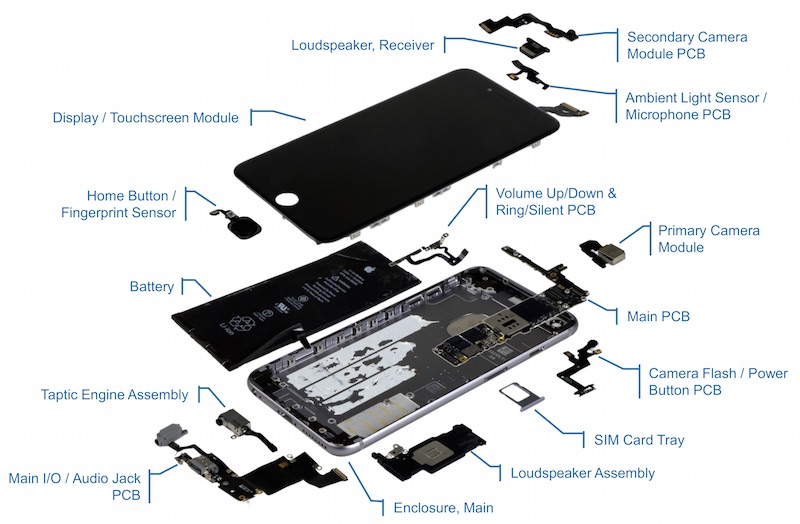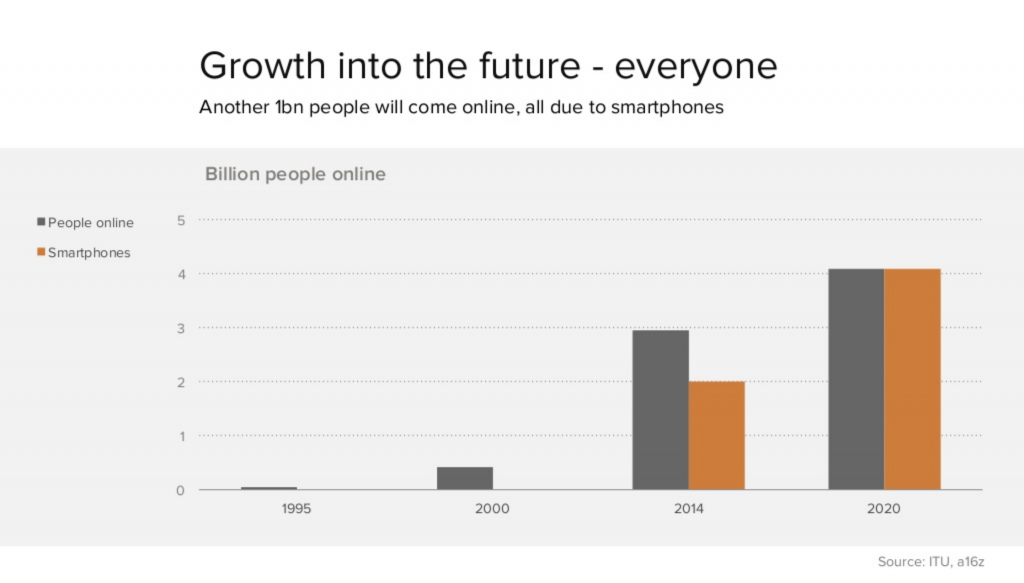
What to watch for
After completing this lesson, you’ll be able to:
- Describe the importance of the smartphone relative to the computing devices that came before it
- Outline the history and functionality of both iOS and Android
- Discuss the broader impact of the smartphone
- Develop an effective skimming practice and apply it to the longer readings in this lesson
There’s so much we could talk about with the smartphone. For most of us, it’s probably both the item we use most frequently and the item we’d miss most if it were taken away. It’s a device that’s thoroughly and radically reshaped almost every aspect of our lives.
But first, before we dive right in, a fun experiment: check Screen Time to see just how much you use your iPhone (if you have one).
Required readings:
📚 “Mobile is eating the world” by Benedict Evans
This presentation by a venture capitalist (and therefore focused on the business implications of smartphones) gives a great overview of the scale and speed of the mobile (smartphone) revolution. Focus on the social aspects, not the business ones1. This chart, in particular, is unreal:

📚 “How Smartphones Revolutionized Society in Less than a Decade” by Casey Phillips
(2,196 words / 11-14 minutes)
A nice quick read about some of the many social changes brought about by the smartphone.
We asked for flying cars and all we got was the entire planet communicating instantly via pocket supercomputers.
📚 Smartphone, Wikipedia
(5,855 words / 30-36 minutes)
(Read the whole article, not just the first part)
Let’s move to Wikipedia for a broader overview of smartphones. Some important details:
- Smartphones (though not in their current, full-fledged computer, touchscreen form) found their first wide-spread adoption Japan in 1999, accumulating 40 million smartphone subscribers by 2001.
- PDAs (Personal Digital Assistants) were important forerunners of modern smartphones.
- The Sidekick, BlackBerry, and Windows Mobile were the major pre-iPhone smartphones in the US.
- The iPhone was announced on January 9, 2007 and shipped on June 29, 2007, launching the modern smartphone era. Competitors dismissed it as an expensive bauble (Steve Ballmer at Microsoft) or, even, as something of a hoax (BlackBerry).
- The first Android phone, the T-Mobile G1, was released a bit over a year later on October 22, 2008.
- Over time, Android devices grew to dominate the smartphone market in terms of market share, but iOS devices, despite their much lower shipment volume, continue to dominate in profit share.
- Take a bit of time to read through the list of discontinued mobile operating systems.
- The list of issues with smartphones provides a decent introduction to a few of the many social issues raised by the smartphone. I’ve been thinking a lot about this tweet / image lately. Smartphones have moved an outer wheel far faster than the inner wheels have been able to keep up with.
Now let’s take a look at the history two dominant smartphone operating systems.
📚 “iOS: A visual history” and “A video history of iOS” by The Verge
(10,568 words / 53-65 minutes)
This piece (and even more so the Android ones that follow) are quite long and very thorough. So, now seems like a good time to talk about skimming!
Skimming 1012: Scan through a table of contents / headings / whatever outlines structure of a piece before you begin. Then, make your way through the entire piece. Learn when to slow down (defining key / new terms, phrases that seem to indicate importance, etc.) and when to speed up (often (but not always) long-winded quotes, signal phrases (though pay more attention to these in less credible pieces), etc.).
Focus on two things: 1) forming a big-picture understanding of the piece and 2) committing to memory the important relevant details (which means you’ve done the thinking while skimming to determine which details are important and which aren’t).
If you’re not an experienced skimmer, it might almost seem like it’s taking you longer to skim than to read. But, with practice, it becomes much more efficient and is a skill that will serve you well not only in college but also in grad school, your career, and life in general. Now, back to the readings themselves:
A few interesting tidbits:
- In general, it’s amazing how much the original iPhone shipped without (copy and paste and the App Store among them!).
- For a long time, it was iPhone OS, not iOS (the release of the iPad in 2010 largely led to this change.)
- Skeuomorphism is a good word to know, at least through iOS 6. 🙂
📚 “Android History” by Android Central and “A video history of Android” by The Verge
(37,521 words / 185-210 minutes, but not really)
(Fun trivia: “A video history of Android” was produced and narrated by NMI alum Ross Miller—maybe say hi to him on Twitter and tell him you’re watching his video as a part of this class!)
(As I said above with the iOS piece, all the pieces of this are important, but a well-executed skimming should be sufficient.)
- Android was created by Andy Rubin, who a) created Danger, the company behind the Sidekick and b) was an Apple engineer for a number of years. It was a standalone company until Google acquired it in 2005.
- Android was originally a very different, keyboard-focused platform; that platform was scrapped before it ever shipped once the team saw the iPhone. As Andy Rubin said, “Holy crap. I guess we’re not going to ship that phone.”
- If you’re not an Android user, you might not know that Android names its OS releases after alphabetically-organized desserts.
- While iOS underwent mostly gradual visual changes (with the dramatic exception of iOS 7’s new aesthetic), the Android UI has radically shifted multiple times, though it’s now settled down into Google’s Material Design look.
- Android is in many ways an open source operating system, but because of its deep integration with Google’s services (Gmail, Maps, etc.), it’s become effectively less open over time.
- The Motorola Droid was the first Android phone that was successful at a mass-market level.
- Google’s Pixel phones are a more recent, more focused effort to develop fully-integrated hardware products, making the whole widget, a la Apple. Their larger project on this front is called Made by Google.3
- Samsung is by far the largest manufacturer of Android phones (and is one of the only profitable ones).
- Android tablets have never really received the same level of software polish as has the iPad.
- You should read a bit about CyanogenMod.
- Google Now, though not an Android exclusive, is a pretty big deal. Learn about it.
Non-required readings
Daring Fireball on the iPhone, App Store, iPhone 3G, (no iPhone 3GS), iPhone 4, iPhone 4S, iPhone 5, iPhone 5S (and 5C!), iPhones 6, and iPhones 6S
John Gruber (the author of Daring Fireball) offers outstanding insight from an unparalleled perspective into the evolution of Apple’s smartphones, which in itself provides a fascinating way to trace the evolution of smartphones.
“The history of Android” by Ron Amadeo
(Note: I highly recommend reading this with Safari’s reader mode—it lets you just scroll to load new pages.) Though two years out of date at this point (and very long), this is an essential resource. Why?
The problem now with the lack of early coverage is that early versions of Android are dying. While something like Windows 1.0 will be around forever—just grab an old computer and install it—Android could be considered the first cloud-based operating system. Many features are heavily reliant on Google’s servers to function. With fewer and fewer people using old versions of Android, those servers are being shut down. And when a cloud-reliant app has its server support shut off, it will never work again—the app crashes and displays a blank screen, or it just refuses to start.
Thanks to this “cloud rot,” an Android retrospective won’t be possible in a few years. Early versions of Android will be empty, broken husks that won’t function without cloud support. While it’s easy to think of this as a ways off, it’s happening right now. While writing this piece, we ran into tons of apps that no longer function because the server support has been turned off. Early clients for Google Maps and the Android Market, for instance, are no longer able to communicate with Google. They either throw an error message and crash or display blank screens. Some apps even worked one week and died the next, because Google was actively shutting down servers during our writing!
Discussion Questions
- Is something other than your smartphone is the most-used item in your life?
- If you reviewed your Screen Time / installed the Moment app, did you learn anything surprising about your smartphone usage?
- What was the first mobile phone you ever saw / owned? The first smartphone? (And: Did you / someone you knew ever own / use a PDA?)
- If you’re an iOS user, have you ever used an Android device? Vice versa? What did you think?
- Do you think there will be another electronic device as significant as the smartphone in our lifetime? Why or why not?
Words on / reading time for this page: 1,387 words / 7-10 minutes
Words in / reading time for required readings: 56,140 words / 279-324 minutes
Total words in / reading time for this lesson: 57,527 words / 286-334 minutes
Unless that’s what’s interesting to you!↩
This is just what works for me; play around and find a system that works for you, but make sure you have a system.↩
Before the current era, Google’s line of “pure” Android phones were offered in a line called Nexus in partnership with a variety of manufacturers. These phones were popular with tech-savvy folks, but never sold very well.↩